Over the past few years, dropshipping has gained incredible popularity from YouTube and other Social Media platforms as one of the best “money making” online businesses to start. What makes dropshipping so great is that you are able to sell products without ever touching them and you don’t even have to sell your own products. Furthermore, you can start selling immediately!
Here’s an overview of how dropshipping works:
- The customer places an order for a product on the retailer’s online store (your store).
- The retailer (You) automatically or manually forward the order and the customer details to the dropship supplier. (Aliexpress, Wish or any other supplier)
- The dropship supplier packages and ships the order directly to the customer without putting any of their branding information on it.
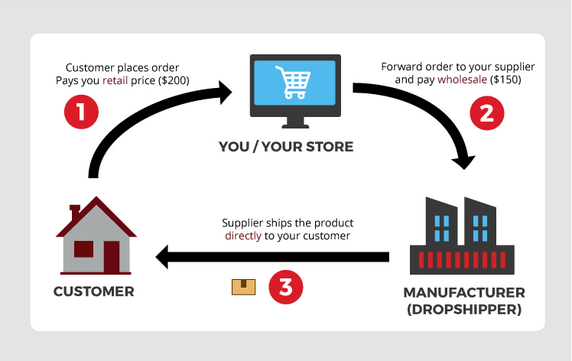
How much money can be made dropshipping?
The truth is that you can make as much as you want with dropshipping. On the beginner level, most stores make about $0-$30k per month. Intermediates tend to make $30-$100k per month. And advanced dropshippers make around $100k and above per month in revenue.
How quickly can you see results?
With dropshipping you can see the results immediately but remember that this isn’t a get rich quick scheme. You need to develop the skill set of learning how to run effective ads and find winning products. The store set-up time can take anywhere between a few hours to 2 weeks depending on how elaborate and fast you can work.
What type of store should you start?
A huge debate in the dropshipping community is figuring out what kind of store you should start. Some gurus recommend general stores, others might say one product stores. I’ll go over the differences to help you.
General Store – A general store is when you are selling any and all types of products. You can think of stores such as Walmart or Target where they sell all kinds of products and also sell many different brands of products.
| Pros | Cons |
| Able to sell a lot of different types of products | Low chance of customer retention or repeat buyers |
| Test many products across many niches | Most visitors won’t view your entire store |
Niche Store – A niche store is a store that sells products related to one category only. Think of a store like Petco, where they only selling pet related products.
| Pros | Cons |
| Able to build more of a brand | Limited to sell one category of products |
| Higher chance of repeat buyers |
One Product Store – A one product store is a store that sells only one product. This allows you to acquire the best supplier, customize your packaging and license your creatives and product – so that nobody can copy you. This means you have a competitive advantage where you sell something very unique to the market.
| Pros | Cons |
| Very unique in customer’s eyes – known for one product | Unable to sell other products |
| Able to deploy more resources and add depth to your product – such as ensuring the highest quality supplier, custom video ads, custom sponsorships/influencer deals |
Verdict: For a beginner, we recommend starting a General Store. A general store allows you to test the field without any restrictions to the kind of products you can sell. As a beginner, you won’t know exactly what will work best for you. Many people create a store around their passions. For example, they might try to create a store around sports because they love sports. But come to find out, they can’t make sales. Or you might create a beauty store because you’ve heard they sell great, but then you only pick products that are over saturated.
A general store gives you the ability to learn and allows your facebook pixel to get some data about what is working. It’s better to sell different types of products, gain experience with a few niches and pick the one you like best after learning from experience. You can then create a niche store or one product store once you’ve tested in your general store what is working. Once you’ve collected a lot of purchase data for one niche or product, you can then use that same Facebook Pixel to market a new store that is more focused on selling one type of product. Now you can benefit from building a brand and getting more customers to buy repeatedly.
How Do You Find Products That Are Working?
Find Trending Products
We believe that the best way to achieve success fast is to model what is working right now. You can try to sift through ads on social media, but our software has already done the heavy lifting for you. We give you the most trending products backed by live data, so you can see real time data such as number of recent clicks, number of video views, likes, comments, supplier information and even projected strength of each product.
With Trending Products, you can simply unlock products that match your interest. I’ll walk you through an example of one of the 2,298 product trends we detect daily.
When you unlock products, you can see their live trends.
See how this Bed Quilt currently has 3,113,417 total video views and a total of 17,101 clicks total. Not only that, we’ve detected that their product page has 442 clicks within the last 24 hours! This means that the store is likely scaling their ad because it’s generating profit.
If you modeled your ad, product page and copy after them, you have a strong chance of doing well. Rather than trying to copy aliexpress products descriptions or scouring the internet for product ideas, why not work off of a proven template that is already generating money?
This is the fastest way we’ve seen to make find winning products and generate consistent sales.
Enabling Our Toolbar
By enabling our toolbar and downloading our Trending Products chrome extension, you can find other winning products on their same store.
Simply click on the best sellers or trending products button at the top of the tool bar and you’ll see the best products that their store is currently selling. You’ll also see a few green boxes with their strength score. The higher the strength score, the better the product will likely perform. Also if you see the box that says Ad next to the product, it means they’re currently advertising those products.
If you ever feel stuck and struggle to find products (which rarely happens using our tool), you can also click on the shuffle button at the top of the tool bar. This shuffles you to a random store performing well that we’ve collected data on.
Search Bar:
Now let’s say you already know the types of products you’ll sell. For example, you have an existing pet store or it’s christmas and you want to capitalize on this spike in demand.
Click on products and type Christmas in the search bar. Now you can go through a long list of products related to your search. My suggestion is to pick the products that have the following criteria:
- High Profit Margins (Over $15 in margin or over 66% if possible)
- Proven data showing a recent trend in clicks or video views
How Do Advertise Your Products?
Facebook Ads:
With Facebook Ads, you always want to test low budget ad campaigns to see which factors are contributing most towards sales.
How to Organize Your Facebook Ads Column
Most beginner advertisers forget to organize their Facebook Columns. This is a critical mistake because you can’t effectively analyze and comprehend how your ads are performing.
For reference, here is how your Facebook Ad Column might look like in it’s default settings.
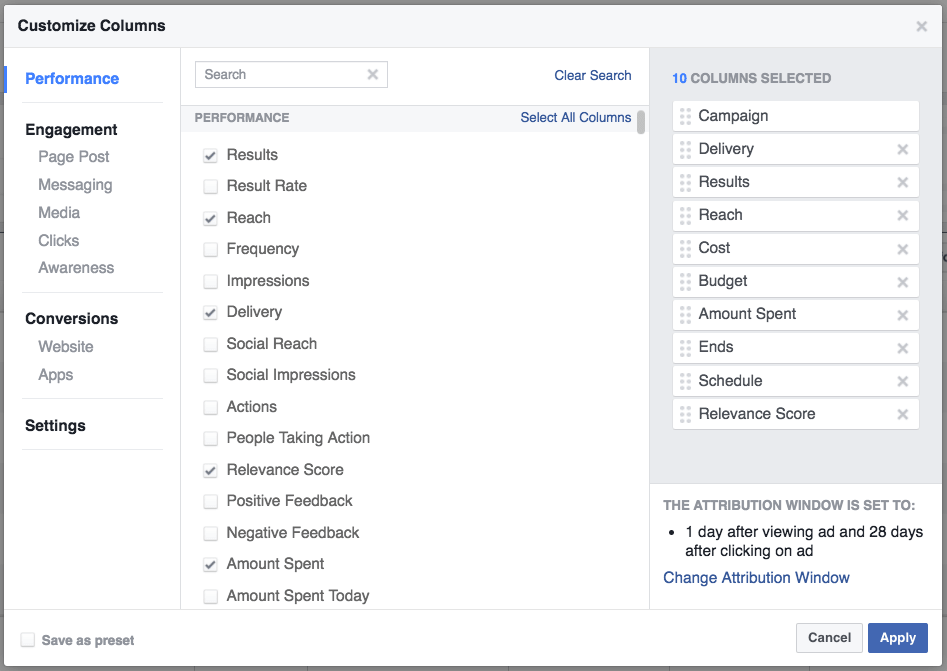
You’ll want to edit the columns to include the following columns in this order:
| Ad Name |
| Budget |
| Amount Spent |
| Link Clicks |
| Cost Per Unique Link Click |
| CPM (Cost Per 1,000 Impressions) |
| Cost Per Add to Cart |
| Add to Carts |
| Cost Per Initiate Checkout |
| Initiate Checkouts |
| Cost Per Purchase |
| Purchase ROAS (Return on Ad Spend) |
| Purchases |
| Purchase Conversion Value |
If you want to learn how to customize the columns in your business manager, simply click here.
For your campaign, you will want to create one campaign with multiple ad sets for each campaign to test various audiences and campaign objectives. Below is a table that showcases one strategy to test products.
Product A Testing Strategy
This table represents all of the ad sets for 1 campaign.
| Ad Set 1 | Budget – $5 | Campaign Objective – Engagement | Location – Worldwide | Audience 1 – Broad (above 5 mil) |
| Ad Set 2 | Budget – $5 | Campaign Objective – Website Traffic or Purchase | Location – Worldwide | Audience 2 – Broad (1-5 mil) Use Interest Based Targeting |
| Ad Set 3 | Budget – $5 | Campaign Objective – Website Traffic or Purchase | Location – Worldwide | Audience 3 – Broad (1-5 mil)Use Interest Based Targeting |
| Ad Set 4 | Budget – $5 | Campaign Objective – Website Traffic or Purchase | Location – U.S., Canada, Australia, U.K., | Audience 2 – Broad (1-5 mil)Use Interest Based Targeting |
| Ad Set #5 | Budget – $5 | Campaign Objective – Website Traffic or Purchase | Location – U.S., Canada, Australia, U.K., | Audience 3 – Broad (1-5 mil)Use Interest Based Targeting |
So for every product you test, you’ll create 1 campaign. And under every campaign, you’ll have 5 ad sets. Each adset, you’ll have a set aside budget of $5. With the first ad set, your goal is to acquire an abundance of cheap engagement to your ad to gain social proof. The more comments, likes and shares you receive on your ad, the better your ad will convert when your audience sees your ad. Ideally you want engagement that costs you 10-15 cents. Sometimes with worldwide targeting, you might receive engagement for as cheap as 2-3 cents each.
Ad sets #2-#5 are meant for testing. The goal of these ad sets are to figure out which ad sets are profitable and which are suffering a loss. You will be testing 2 ad sets with worldwide targeting and 2 ad sets testing english speaking countries. Then each ad set you’ll be targeting a broad audience that could be interested in your product, ideally around the size of 1-5 million people. This allows for a wide enough audience to scale later on.
Notice I’ve highlighted 2 of these audiences in the table. This means you’ll be testing 2 different audiences in each location targeting.
How do you find interests to target?
The best way to find interests to target is to simply type in keywords and then click on suggestions. Facebook will give you suggestions related to your keyword.
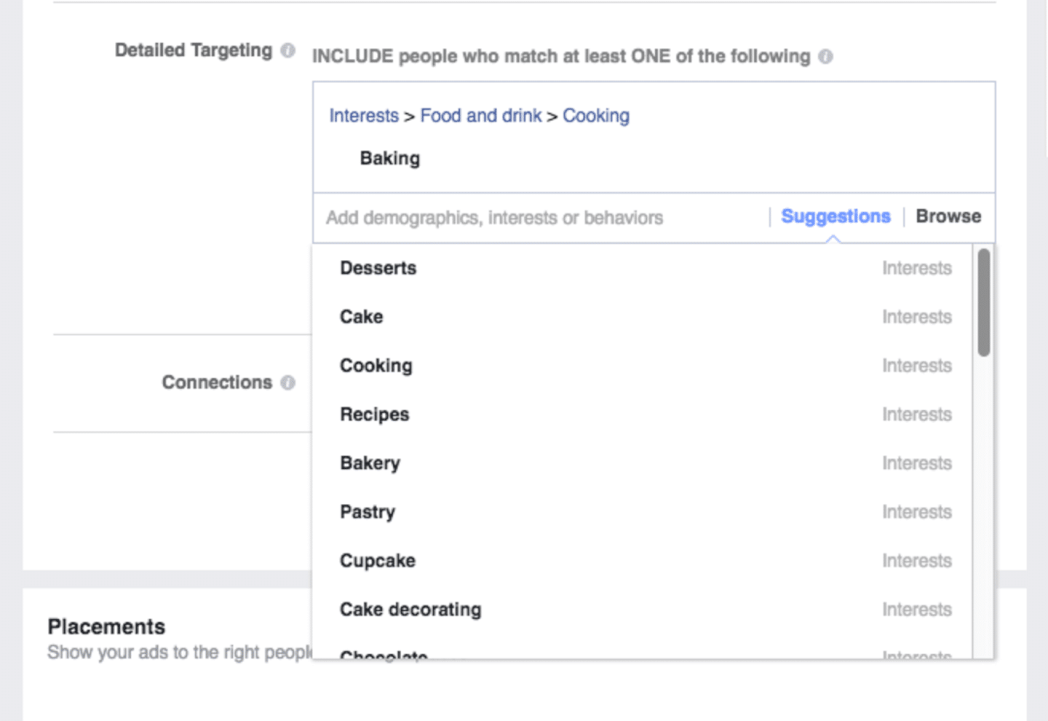
This is an example of baking. However, you might want to do further research of baking shows or famous brands related to baking. For example, let’s say you sold a golfing club. Your average fan would know who Tiger Woods is, therefore Tiger Woods might not be the best option to select for interests. But choosing the 10th ranked golfer, only the die hard golfing fans would know about. Same with baking, most people couldn’t even name one brand related to baking.
How long should you run these ad sets for?
You’ll be leaving these ad sets on for about a few days minimum to see how they perform. If your product has a $20 profit margin, you should at least wait 4 days before cutting that ad set. This is because your ad budget is $5 and it’ll take 4 days to reach $20. If you don’t reach a sale within 4 days, you may cut it. If you don’t reach an add to cart by the halfway point of $10 spent, you should also cut it.
Basically here are the general rules to follow:
- You may cut the ad set, when you’ve reached the break even point where cost is equal or exceeding your profit margin.
- You may also cut the ad set, when you’ve spent half of the profit margin amount and haven’t yet received an add to cart yet.
Scaling:
Okay, let’s say you’ve found a product that is making you a 1.5x, 2x, or even 3x return on investment. This means that you’re making more money than you would spend on advertising and product cost combined. You’ll be able to find this number under the column, Purchase ROAs (return on ad spend).
Fortunately, scaling is the easy part! To scale, all you have to do is throw more wood to the fire! Here are a few ways to scale.
Increase Budget: You can simply increase your ad set budget or duplicate the ad set that is profitable. So if one ad set is working, increase that ad set from $5 to $10. Or you can duplicate that winning ad set so you have 2 ad sets that are the exact same of $5 each.
Different Locations: If you see one location targeting is working, double down on the biggest countries and cities. For example, if you’ve noticed United States, is doing well try going for big states in the U.S. Or try finding other countries that would do well.
Related Audiences: If one audience is working, find other related audiences very close to the winning ad set audience and scale. Or pick out broader audiences with a larger audience size.
Lookalike Audience – Once you’ve received a lot of pixel data from website traffic, add to carts, purchases etc, you may use that data to find new similar audiences. For example if you’ve received a lot of purchases, you can create a lookalike audience with similar profile data points to the people who’ve bought your products already.
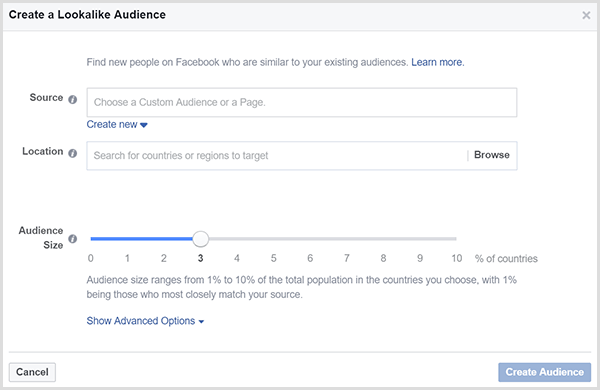
Facebook can create up to 10 lookalike audiences ranging from 1-10%. You can test all 10 audiences to see which performs best. You can even test lookalike audiences for each country. That’s 10 new audiences per country you select.
Lookalike audiences is by far one of the best ways to scale and this is why having a strong Facebook pixel is vital to your dropshipping business.
Manual Bidding – Since you already have a profitable ad set, you can likely outbid other individuals. For example, if you know it costs you $15 per purchase and your profit margin is $20. You can set a rule to your manual bidding to say, I’m willing to only spend $15 for a purchase. If I don’t get a sale for every $15 I spend, I’m cutting this ad set.
Other Ad Placements – If you’re only showing your ad on the Facebook News Feed, you can begin showing your ads to Facebook Stories, Instagram Feed, Instagram Stories, Apps, Facebook Articles etc.
Testing Products with Instagram Influencers or Scaling:
The advantage of Instagram Influencers is that you’re able to receive pixel data very fast and likely receive sales quicker. Also there are pages with millions of followers that you are reaching.
Step 1: Find niche related pages or meme pages.
Any page with a very high engagement rate, you should consider.
Here are a few examples of different niches to give you ideas.
@catsofday
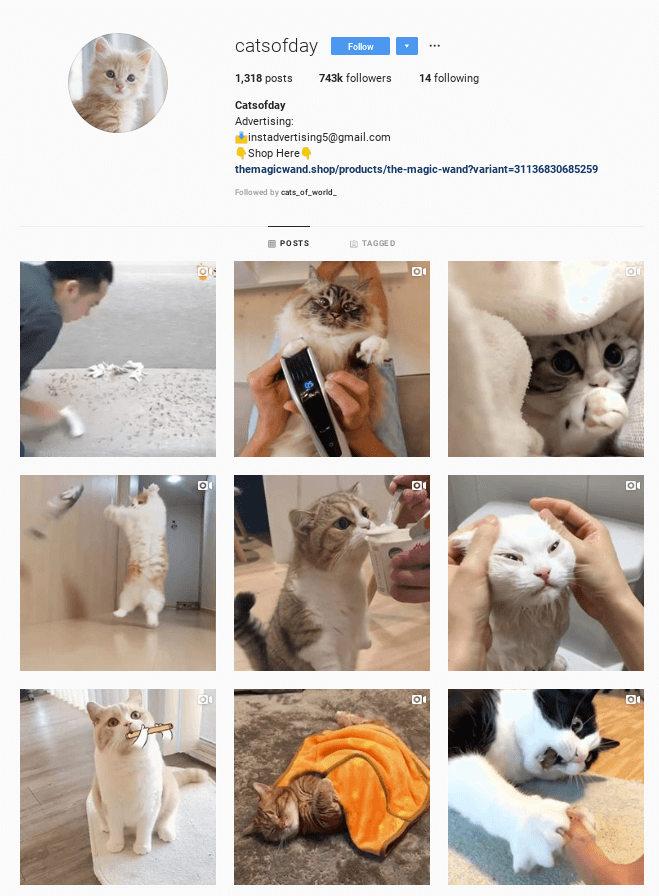
@mealprepdaily
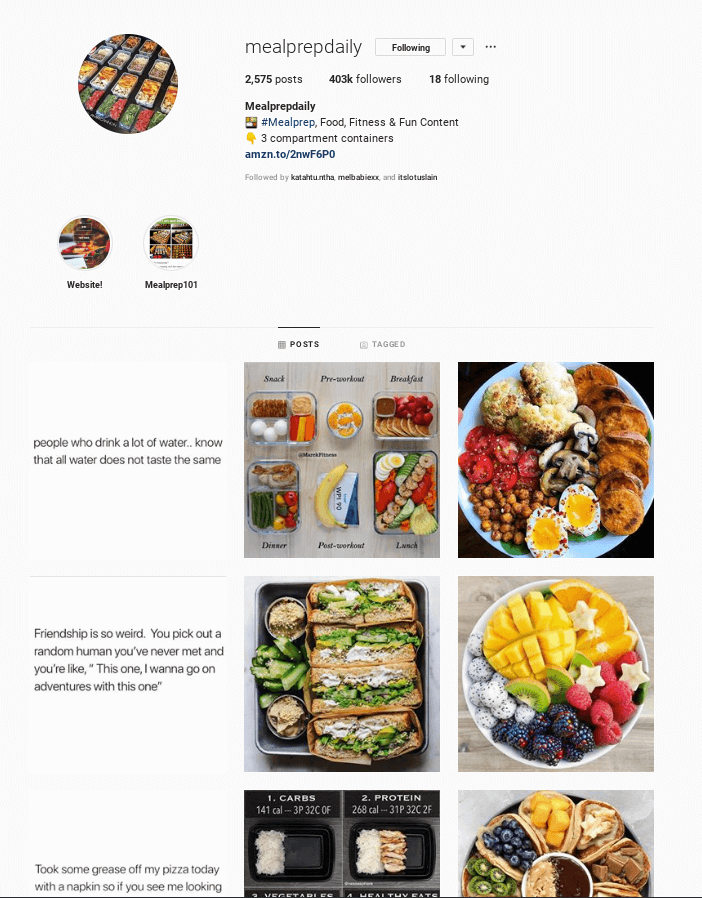
@moodyteenpost
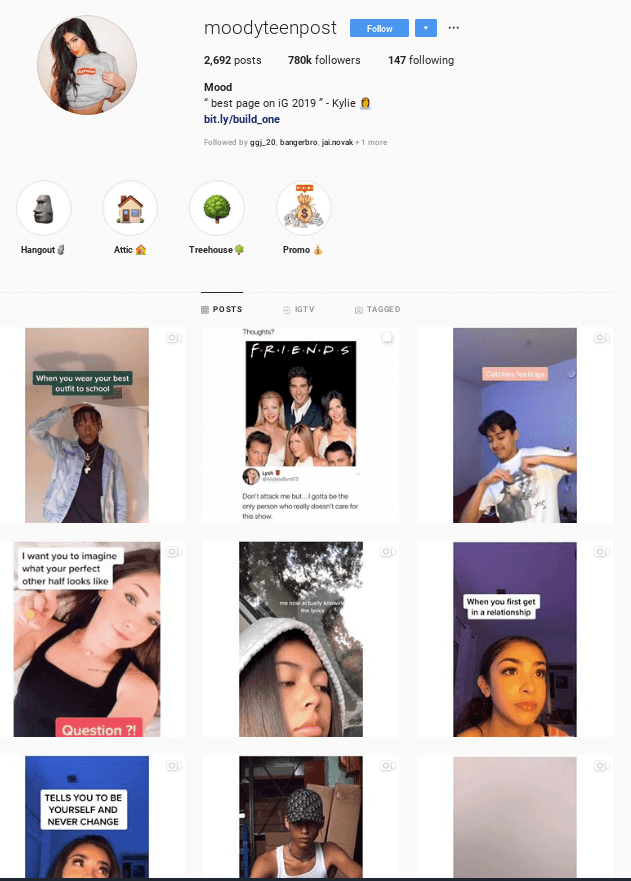
Step 2: Contact a bunch of pages and work with pages in your budget. For testing products using Instagram, I recommend starting off with smaller pages that charge $30-50. Depending on the niche, they might have $100,000 to $500,000 followers.
Step 3: Schedule your Influencer Ad.
Conclusion:
Here’s the recap for making $500 per day fast!
Step 1: Find Trending Products and model what is already working.
Step 2: Use Facebook Ads and Instagram to test multiple products per day
Step 3: Once you’ve found a winning product, scale that product further.
To make $500 a day, you only need one good product, that’s all! Remember that most dropshipping stores only have 1-3 products that make 80-90% of their revenue.
Once you’ve done all 3 steps, you want to rinse and repeat to find more winning products. Unfortunately, winning products won’t sustain you forever, unless you have a brand. Therefore, you have to continue finding and testing new products to eventually capture new winning products.
Luckily, our software makes product research a breeze and since you see live data, you are more confident knowing you have the numbers to increase your chances of success.
Remember, your goal is to make your first sale! There’s nothing like the feeling of making your first sale online. Once you’ve done that, now aim to make your first $100. Remember, you just need one good product, and you can easily make $500 per day with dropshipping!


